This post originally appeared on Murder Is Everywhere.
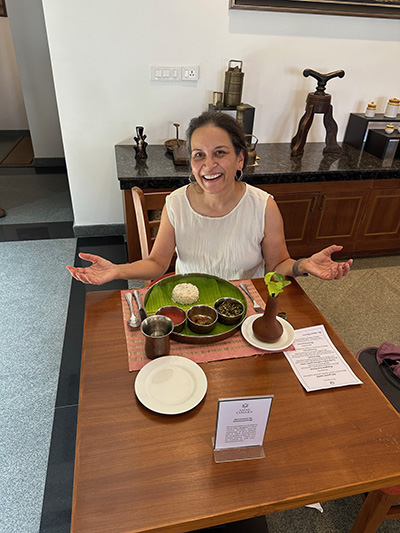
Friends, I am back in India. It turned out that my wonderful October-November visit to India was not fulfilling enough. During that two-week journey, I’d gathered the information to finish one Perveen mystery; but now I was itching to learn more about Kerala for a subsequent book. I’d also luxuriated in a few Ayurvedic massages that reduced my chronic neck pain and made me contemplate whether three weeks of daily treatment might cause the entire problem to go away.
I was still jet-lagged when an ad arrived in my inbox for a Black Friday airfare sale at Etihad Airways. Etihad is my favorite carrier to fly to India because it’s a straight flight from Washington’s Dulles airport to Abu Dhabi, and then less than 4 hours to a variety of cities in India: not just Delhi or Mumbai. I thought about it for a few days. And the morning after the turkey was roasted, I’d bought myself a round trip ticket for a 28-day visit to Kerala.
I arrived last Friday on a hot, sunny morning. I rode two hours in an air conditioned van to a village in the Alepuzzha district called Manannchery. Here lies Amal Tamara, a 5-star hotel that is also an accredited Ayurvedic hospital with a medical faculty, physical therapists, and its own pharmacy department.
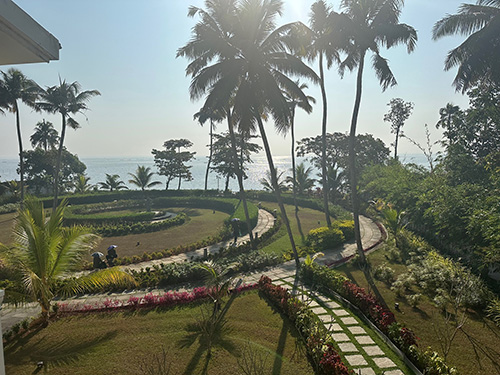
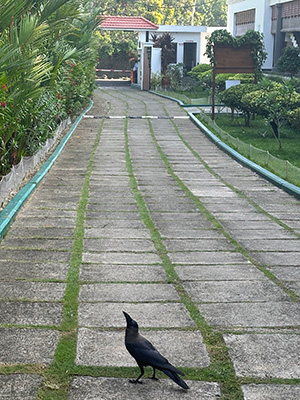
Kerala sits at the southern tip of India, where the monsoon arrives first. This state gets the most rainfall of any location in India and is famous for its green fields, massive mountains, and a network of rivers and lakes known as the Backwaters. Perhaps because of the very high temperatures most months of the year, the people of Kerala developed a pattern of refreshing, oil-free cooking. Ayurveda, the ancient medical system of India, began in the north, but it’s said that eight saints traveled south and brought their wisdom to Kerala, where Ayurveda took root more deeply. Throughout the state, hundreds of public and private hospitals and hotel resorts offer massages with medicated oils and powders and special herbal prescriptions. The safest places are certified by a national board of Ayurvedic medicine.
Another aspect to Ayurveda treatment is following a daily diet based on one’s grouping in three general body/constitution types: Vata, Pitta and Kappa. Food can be used to support one’s personal affinities and also vulnerabilities. Many people follow these food principles at home using books and advice from their Ayurved, as the doctors are called. However, staying at Ayurvedic facility gives people a chance to taste a whole lot of interesting and healthy Indian food and not to have to worry about cooking. Everything is customized and served; unlike a regular hotel, one doesn’t make choices about portion or type of food. After all, food is medicine.
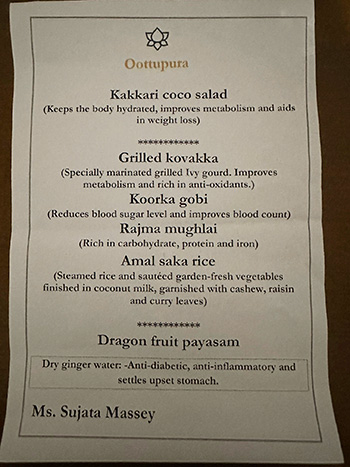
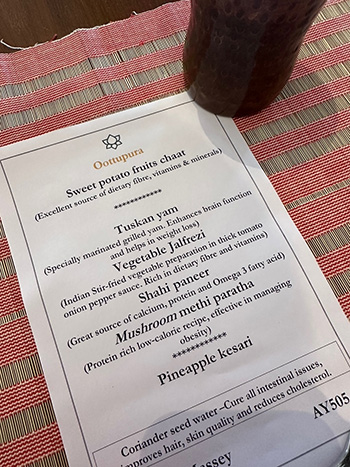
Some samples of my personal prescribed menus are above. Each time I come to my table (dining in silence without use of devices is encouraged), a cup of warm water arrives in a copper cup along with my menu. A serving of two vazhakoomvu tikka, perfectly crispy banana-flower fritters, is “rich in fibre and protein, effective in treating infection and shows down the aging process.” Idichu thalichathu, stir-fried yam with crackled mustard seed and curry leaves, “enhances brain function and helps in weight loss.” Cheera Mappas, sautéed red spinach in coconut coriander gravy, “restores energy, improves vitality and blood count.” Promises, promises! If I live here forever, does it mean I’ll always be alive?
The food served is so varied that it’s quite likely a person is eating 40 different plant foods a day. Maybe more. And I appreciate the novelty of the ingredients which are rarely seen at upscale Indian restaurants. Yams, Ivy gourd, and drumsticks might not sound exciting—but these popular home-grown Kerala vegetables are when shared in traditional and fusion recipes. You wash all this deliciousness down with glasses of warm water flavored with a different beneficial spice every day. I’ve had cumin, coriander, dry ginger and cardamom water so far, and the taste is quite subtle.
So what’s off the table? Meat, fish, salt, oil, refined sugar, white rice and white flour, caffeinated tea and coffee, and alcohol. Even though I know I’ll taste these foods again some time, I’m not craving them. These Ayurvedic dishes are so prettily presented and tasty, that one forgets. And while portion sizes are petite, the fiber content is high enough that I’m only hungry before breakfast. There are no machines with snacks if you get hungry in the wee hours or have that restless boredom that leads to thinking about a quick bite. But I confess to stockpiling some of the delicious peanut burfi and sesame jaggery balls that Amal Tamara provided for me in the car that came to Kochi International Airport. My four remaining “Healthy Bites” were devoured the first time I woke up at 3:30 am. I’m still awakening far too early, so the doctor kindly allowed me to have apples and bananas in the room. We take our prescribed medicines at 7:30, after sunrise yoga, and we eat breakfast at 8, lunch at 1, and dinner at 7. There are only about a dozen guests here—it’s a small hotel—so we are getting to know each other well during this moment of pursed lips and grimaces.
Food as medicine is a much happier moment of the day.
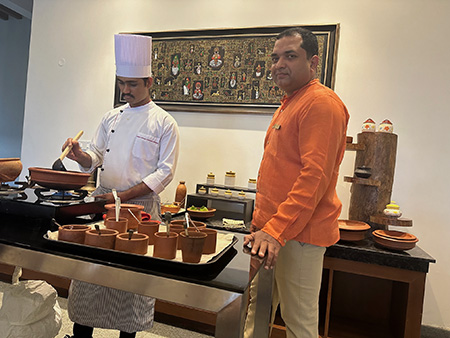
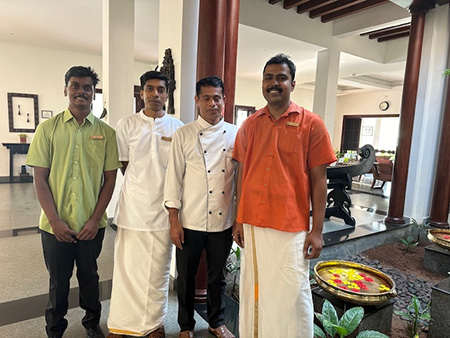
Breakfast always starts with fruit and continues with some protein, often a South Indian favorite like dosa or uppma.
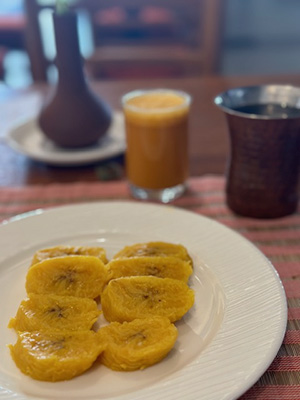
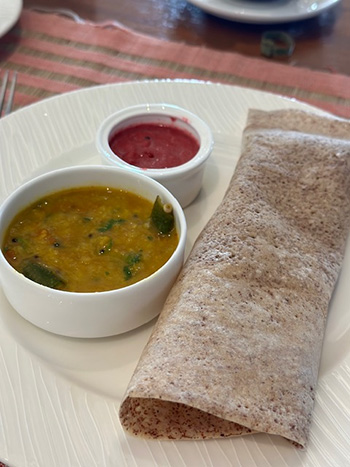
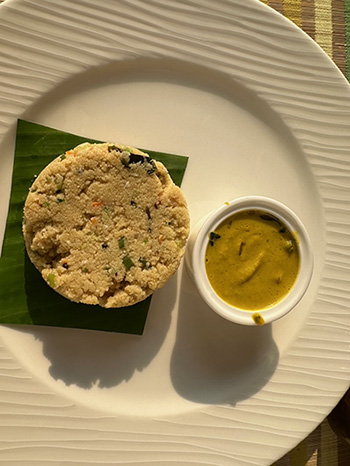
Lunch is always the biggest meal; it comes with a starter and dessert.
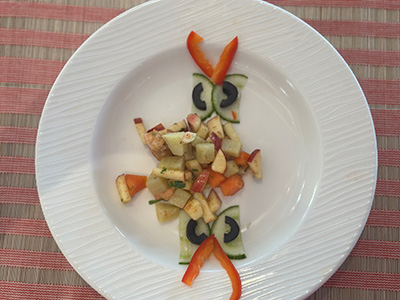
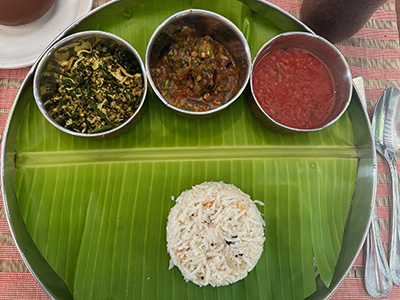
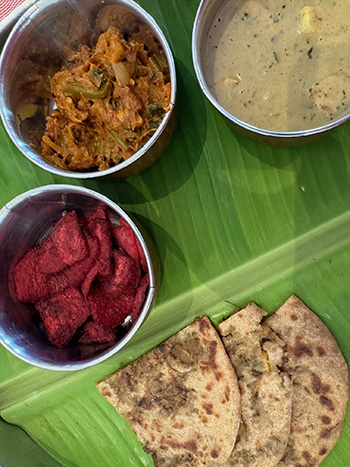
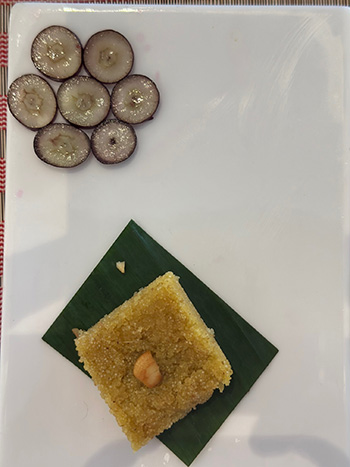
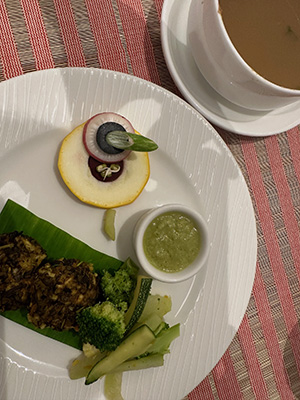
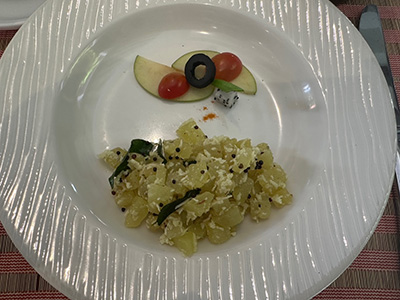
Dinner is often a pureed soup followed by a vegetable dish, a flatbread and… no dessert.
And speaking of sweets, one of my massage therapists, Nithu, chatted about her young son’s birthday celebration a few days earlier. His school has a rule forbidding the kids’ families to bring a cake or candy to school. Instead, parents are encouraged to send a bag of vegetables. These vegetables are cooked by a school chef into a healthy curry served to the class for the birthday celebration.
A clever idea, at least from the grownups’ point of view.
